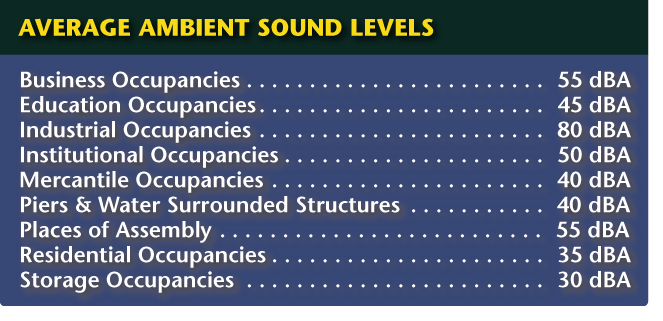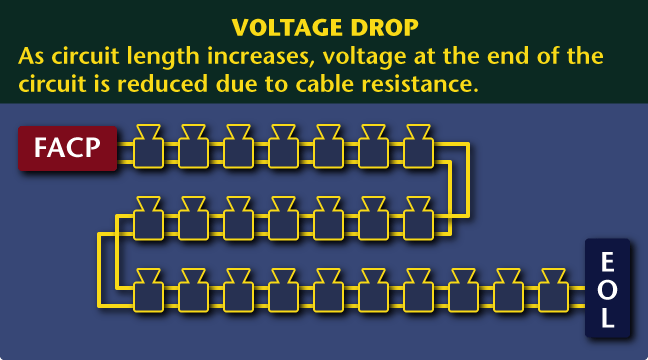Everyone struggles with the code language and that leads to misinterpretations. One common misunderstanding is that NFPA 72, National Fire Alarm Code, requires fire alarm notification appliances to be installed. Not so! In fact, NFPA 72 doesn’t require anything to be installed with the exception of a smoke detector to protect fire alarm control units and a single manual fire alarm box when the fire alarm system has automatic devices such as smoke detectors or waterflow switches connected to it.
The requirement for when a fire alarm notification appliance is required can be found in fire and building codes, such as the International Building Code, International Fire Code and the NFPA 101, Life Safety Code. It is vitally important to know which codes are enforced in your area, and if there are any local amendments to it that affect fire alarm systems. NFPA 72 only explains how to install these appliances – how loud or how bright it must be or how high it must be mounted.
For example, if you are only required to install a fire alarm panel to monitor a sprinkler system, the only notification appliance typically required is the sprinkler bell or horn. This type of system is commonly called a sprinkler supervisory system, although in reality it is a very basic fire alarm. Unless the local amendment to the code specifically requires “occupant notification,†you are not required to install horns and strobes throughout the facility. When in doubt, discuss it with your local fire marshal.
Fire Alarm Audibles: Where & How Loud
If the requirement for the fire alarm system is found in the Fire Alarm section of the code, then you need to install horns and strobes to notify the occupants. The question is: where?The International Building Code (IBC), which is used in most states, requires audible alarms “in every occupied space within the building.†It requires visible alarms in public and common areas and in a certain percentage of sleeping rooms in I-1 (such as residential board-and-care facilities, assisted-living facilities, etc.) and R-1 (hotels and motels). A good rule of thumb is to provide strobes wherever the public could be in a building. There is a table in Section 907 of the IBC to show how many sleeping rooms must have strobe lights installed. You do not have to install them in every room. It will also state the circumstances under which you should install an emergency voice alarm communication system. These are typically installed in assembly occupancies and malls, where there are a lot of people at one time. These systems are installed to allow the fire department to talk to the occupants and direct an orderly evacuation.
NFPA 72 states that these audible fire alarm notification appliances must be a minimum of 15 dBA above the average ambient sound level. What is the ambient sound level? It is the average sound measured over the time the building is occupied. Because most companies do not measure this, it would be wise to consult with your local Authority Having Jurisdiction (AHJ) to make sure you have a mutual understanding of this before you install the horns. If you don’t do this, you stand the chance of failing the fire alarm audibility test.
NFPA 72 also states that you have to have a minimum of 75 dBA in sleeping areas (up from 70 in the 1999 edition). The only way to ensure you will achieve this is to use a sound-level meter. Get a good one that can be calibrated. That will alleviate any doubts a fire inspector may have. In addition, the International Building and Fire Codes state that you must have a minimum of 70 dBA in Group I-1 and R-1 occupancies, 95 dBA in mechanical equipment rooms, and 60 dBA in all other occupancies.

Synchronizing Audible Devices
In the 2002 edition of NFPA 72, a new requirement for synchronizing the audible devices was implemented. Because the required sound pattern is a three-pulse temporal signal, it is important that when multiple audible appliances can be heard at the same time, you can distinctively hear the three tones and they are not jumbled together. Strobe lights only have to be synchronized when you can see more than two at the same time.As far as strobe light requirements, the building and fire codes state where you must install them; NFPA and the Americans with Disabilities Act Accessibility Guidelines (ADAAG) state how to install them. Since the ADA was implemented in 1990, there has been a tremendous amount of confusion about strobe light requirements. The problem is that ADAAG requires a minimum of a 75 candela strobe to be mounted 80 inches above the floor (or suspended 6 inches below the ceiling, whichever is lower). NFPA 72 allows strobes to be a minimum of 15 candela (in non-sleeping rooms) and mounted either on the wall between 80 and 96 inches, or ceiling mounted. So what do you do? The ADAAG offers some relief through what they refer to as “Equivalent Facilitation.†Basically, this paragraph allows installers to follow NFPA requirements as long as they meet the intent of the ADA –– making building occupants equally protected regardless of impairments. The ADA has been rewritten to eliminate all of these requirements and now simply refers to NFPA 72 for installation guidance. This change has not been officially adopted yet by the Department of Justice. For more information on the proposed changes to ADA, visit http://www.access-board.gov/ada-aba.htm to read about the proposed changes.
NFPA 72 also made a change in the 2002 edition that will allow fewer strobe lights to be installed in corridors if installers use higher candela strobe lights and follow the room spacing requirements instead of the corridor spacing requirements of installing strobe lights within 15 feet of the ends of the corridor. This can significantly cut down on the number of strobes that need to be installed if there are a lot of corridors.

Voltage-Drop Calculations
Another very important issue installers need to consider is voltage-drop calculations. The building and fire codes today require that voltage-drop calculations be provided as part of the plan review documentation. These are especially important on notification appliance circuits. It is vital to ensure the last horn/strobe on the circuit will work when needed. There is a tremendous amount of confusion about these calculations. First, there is no requirement in a national code or standard for any specific voltage-drop percentage. There are a lot of myths, but no actual requirements.There also is nothing in the codes and standards that specify what your starting voltage should be. Installers need to ensure that the voltage at the last appliance on the circuit is at least the minimum required for operation. Look at the installation instructions (you know – the packing material that comes with the horn/strobe) to learn the range of operation for the appliance you are installing. The latest UL requirements stipulate that these devices operate from 16 to 33 volts. So, you need to ensure the last horn on the circuit has at least 16 volts – under worst-case conditions – when there is an alarm.
What starting voltage do you need to use? If you measure the voltage at the notification appliance terminals in the fire alarm control unit, you will probably have somewhere around 26 to 28 volts for a 24-volt fire alarm panel. Should you use 24 volts as a starting voltage for your voltage-drop calculations? Absolutely not! Consider the fact that the building power may be off and the system is running on the batteries. What do you think the voltage at those terminals will be if you measured it after 23.5 hours of battery operation? It will probably be down around 20 or 21 volts. In fact, UL 864 considers 20.4 volts as the end of the useful life of the battery (this is essentially a 15 percent voltage drop – 24 minus 3.6 volts is 20.4 volts).
Experts recommend using 20.4 volts as your starting voltage. Make sure the voltage at the last device is not below 16 volts, and use the resistance tables in the National Electrical Code to determine the resistance of the wiring. Go to the Automatic Fire Alarm Association’s website, www.afaa.org, and click on “Tools.†There you will find a Microsoft Excel spreadsheet to perform voltage-drop calculations, which is available for download at no charge. Simply enter the size of your wiring conductors, the starting voltage (remember, 20.4 volts), the current draw of each appliance, and the distance between devices; the program will calculate the voltage drop for you. Print it out and attach this to your plan review submittal and the AHJ should be pleased.
Just remember that the “when required†is found in the building and fire codes; the “how to†requirements are found in NFPA 72. When you have a question about the requirement, talk to someone at your local fire marshal’s office. They can be your best friend when it comes to installing fire alarm systems.
Sidebar: UL 864 Proposed Changes Could Upset Installing Companies
UL 864 (Standard for Fire Alarm Control Equipment) will be coming out with its ninth edition sometime next year, possibly in March 2006. Some of the proposed changes will certainly affect installing companies and end users.Control panel notification appliance circuits will now have to be listed for either “Regulated†or “Special Application†use. If the manufacturer lists its circuits as Regulated, there is no problem. Any regulated audible notification appliance will work on any regulated notification appliance circuit. That is basically the way panels have operated for many years.
However, if the manufacturer lists its circuits as Special Application, then installers will have to use either the appliance listed as compatible, or reduce the number of regulated appliances they wish to use by about 50 percent. That can have a significant impact on installing companies doing a renovation or replacing a damaged panel. You may have a hard time figuring out which (and how many) horn/strobes you can connect to a given panel when you buy it at your local distributor.
This can also affect end users. They may be required to either replace all horn/strobes or add power boosters when the panel is replaced.
There also may be significant enforcement problems by the AHJ. This issue is being hotly debated by manufacturers at this time. The problem may be resolved, but in the meantime it is one that the fire alarm industry should observe.